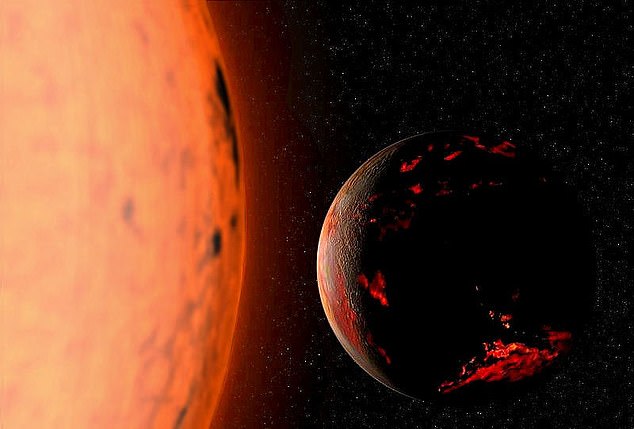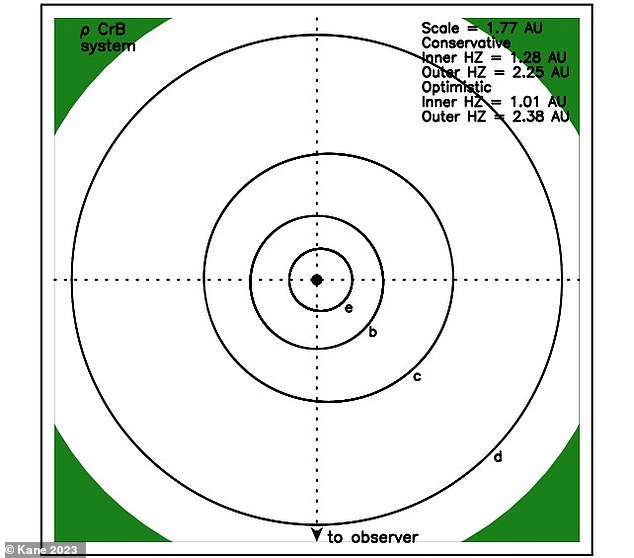Is this how Earth goes out, too? Scientists say sun will expand to 1,000 times its size and obliterate our planet instantly – after studying similar transition of a star in outer space
>
Our Sun is expected to expand to 1,000 times its size in the final stages of its life, instantly wiping out Earth, and a distant star will act as the cataclysmic event.
New mathematical calculations for Rho Coronea Borealis, located in the habitable zone 57 light-years away, reveal that it is nearing the end of its life cycle and will transform into a red giant in about a billion years.
All four known plants orbiting the star will be affected by the stellar atmosphere, some evaporating and others being torn apart.
Scientists first hypothesized the same fate for our Sun in the 1940s, but concluded that it was unlikely to happen for another five billion years.

Our Sun is expected to expand to 1,000 times its size in the final stages of its life, instantly wiping out Earth — and a distant star will play the cataclysmic event.
“We show that the three inner planets (e, b, and c) were swept away during the red giant phase and asymptotic giant branch, and those planets were likely destroyed by either evaporation or tidal disruption,” the study published in the journal arXiv.
Rho Corona Borealis is a yellow-orange main sequence dwarf star with a mass of 96% that of Earth’s Sun, 1.3 times the radius and 1.7 times its luminosity.
However, Rho Coronae Borealis is twice as old as our Sun, which is 4.6 billion years old.
The sole author of the new paper is Stephen R. Kane, of the Department of Earth and Planetary Sciences at the University of California, Riverside, set out to see what happens to exoplanets orbiting tightly around the star once it expands. The universe today Reports.
Kane used the model of stellar evolution to observe the effects once a star turns into a gas giant.

All four known plants orbiting the star will be affected by the stellar atmosphere, some evaporating and others being torn apart.
The stellar evolution model is a mathematical model that can be used to calculate the evolutionary stages of a star from its formation until it becomes a remnant.
Kane wrote that he and his team overlaid the properties of evolving stars versus planet orbits.
All three planets are at least Earth-sized, and the two closest are closer to the star than Mercury.
The model predicted that the star would become a red giant at 11.5874 gyers – one gyre equals one billion years.
The planets e, b, and c are swallowed by the star at stellar ages of 11.5630, 11.5785, and 11.5846 gyrs.
The study says: “At this point the star includes all the planets except the outer planet, D.”
“At 11.7088 Gyrs, the star engulfs Planet D again.”
“Although all the planets will enter Rho CrB’s stellar atmosphere, their individual predictions vary greatly,” explains Ken.
The world believes that planet e is terrestrial and will It evaporates instantly.
Planet B is larger than Jupiter and will spiral out of control as the Sun expands, causing a ripple effect on Planet C.
Planet D will then be swallowed, but Kane points out in the study that it is possible to push the world into another orbit.
“The evolution of stars through their progression up the main sequence, expansion into a giant star, and eventual contraction into a white dwarf has profound consequences for the planets around which they orbit,” Kane wrote.
‘Given the masses and semi-major axes of the four known planets, we expect that planet e will evaporate into the stellar atmosphere, planet b will spiral in and become tidally disrupted, potentially further amplifying the star, and planet c will evaporate into the stellar atmosphere.’
(Tags for translation)dailymail
